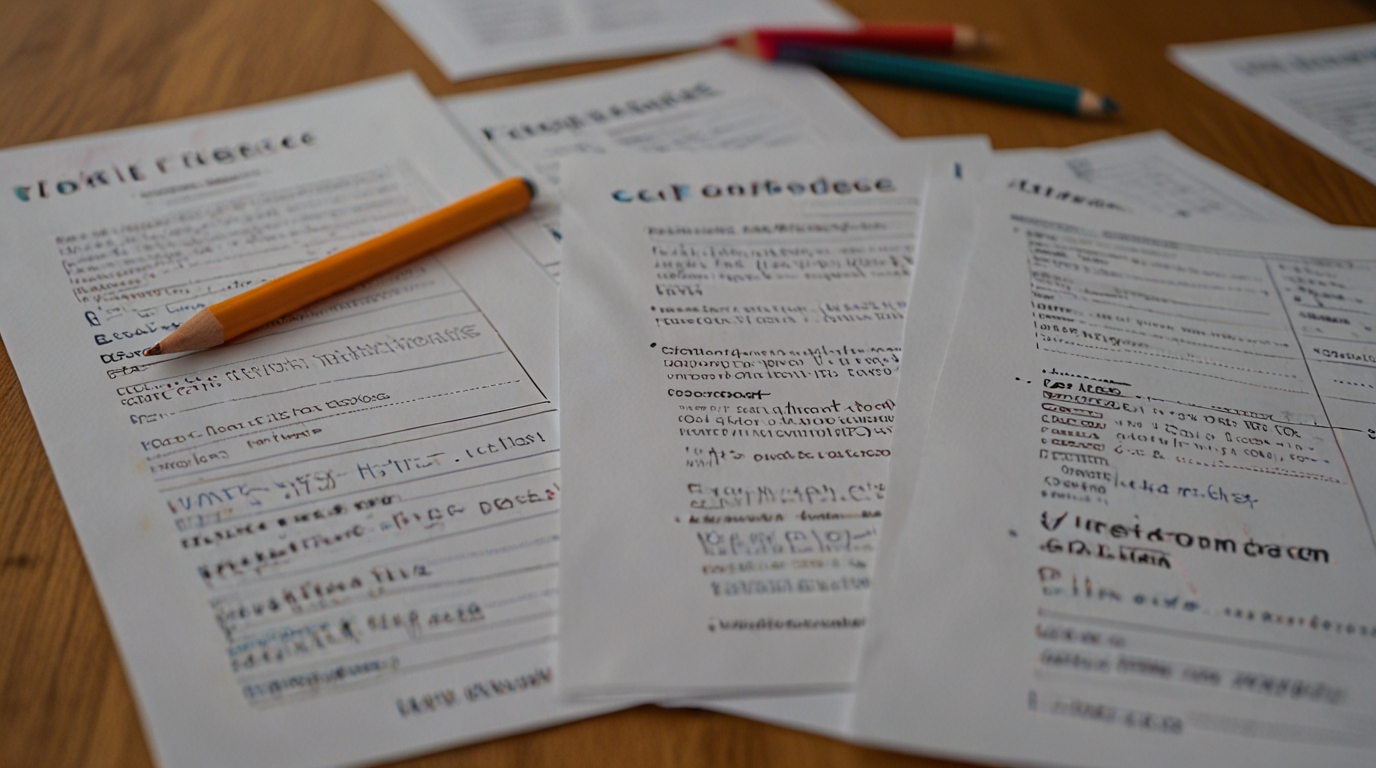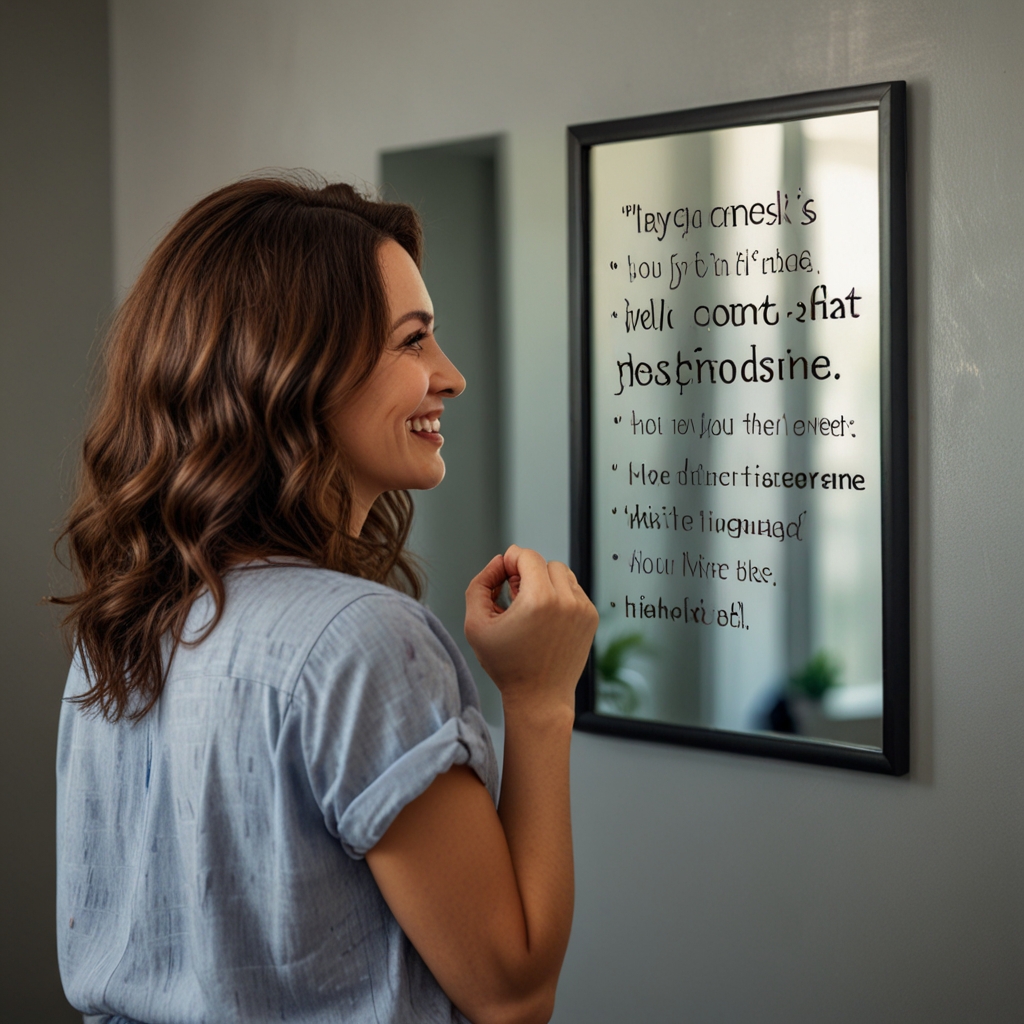Introduction
Have you ever felt that nagging doubt creeping in, whispering that you’re not good enough?
We’ve all been there.
For me, it was during a crucial presentation at work. My hands shook, my voice wavered, and I couldn’t shake the feeling of being an impostor. That experience made me realize how deeply negative core beliefs and negative self-evaluations can affect our lives. It wasn’t just about that moment; it was about every missed opportunity, every time I held myself back because of low self-esteem.
But here’s the good news: you’re not alone, and change is possible.
Self-confidence is not a trait we’re born with; it’s something we can build and nurture. We can shift our negative thoughts to more empowering beliefs through the right tools and practices. Imagine waking up each day feeling capable, worthy, and ready to tackle life’s challenges with a smile. It starts with understanding and addressing the negative automatic thoughts undermining our confidence.
This guide is your companion on this journey. With carefully designed self-confidence worksheets for adults, practical exercises, and insightful resources, you’ll find the support you need to develop positive self-esteem and reclaim your personal power. These tools aren’t just about feeling good at the moment—they’re about creating lasting change, helping you to lead a more fulfilling and confident life.
So, are you ready to take the first step towards a more confident you? Let’s dive in and start this transformative journey together.
Understanding Self-Confidence

Definition of Self-Confidence and Self-Esteem
Self-confidence refers to the belief in one’s abilities and judgment. It’s an assurance that you can face challenges and handle tasks successfully. This confidence often manifests in carrying yourself, making decisions, and interacting with others.
Self-esteem, on the other hand, is the overall sense of personal worth and value. It’s how you perceive yourself deeper, encompassing your beliefs about your worthiness and capabilities. Healthy self-esteem means valuing yourself regardless of circumstances, whereas low self-esteem can lead to feelings of inadequacy and self-doubt.
Differences Between Self-Confidence and Self-Esteem
While the terms are often used interchangeably, there are key differences:
Self-confidence is situation-specific. You might feel confident in your ability to excel at work but less confident in social situations.
Self-esteem is a more general and stable sense of self-worth. It influences how you feel about yourself overall, regardless of specific situations.
Improving self-confidence often involves building skills and knowledge in particular areas, while enhancing self-esteem involves shifting your self-perception and embracing self-compassion.
Importance of Self-Confidence in Personal and Professional Life
Self-confidence plays a crucial role in both personal and professional spheres:
Personal Life: High self-confidence leads to better relationships and greater life satisfaction. You’re more likely to pursue your interests, set boundaries, and assert your needs. It also helps overcome negative thoughts and core beliefs, promoting a more positive and fulfilling life.
Professional Life: Confidence at work can lead to better performance, increased job satisfaction, and career advancement. It allows you to take on new challenges, innovate, and lead effectively. Employers value confident employees who can communicate assertively and handle responsibilities with assurance.
Whether applying for a new job, starting a conversation with a stranger, or standing up for yourself, self-confidence is key to navigating life’s challenges with resilience and grace. Understanding and fostering self-confidence and self-esteem pave the way for a more empowered and successful life.
Common Issues with Self-Confidence

Identifying Low Self-Esteem
Low self-esteem is a pervasive issue that can significantly impact various aspects of life. It often starts with how we perceive ourselves and our abilities. Identifying low self-esteem is the first step toward addressing and improving it.
Symptoms of Low Self-Esteem
Recognizing the symptoms of low self-esteem can help in understanding its impact:
Constant self-criticism: Regularly thinking you’re not good enough or can’t achieve your goals.
Avoiding challenges: Preferring to stay within your comfort zone to avoid failure.
Negative self-talk: Using a harsh inner voice focusing on failures rather than successes.
Perfectionism: Setting unrealistic standards for yourself and feeling inadequate when they are unmet.
Social withdrawal: Avoiding social situations due to fear of judgment or rejection.
Difficulty accepting compliments: Feeling uncomfortable or disbelieving when receiving positive feedback.
Effects of Low Self-Esteem on Behavior and Mental Health
Low self-esteem can profoundly affect behavior and mental health:
Increased anxiety and depression: Persistent feelings of inadequacy can lead to anxiety disorders and depression.
Poor decision-making: Lack of confidence can result in hesitation and missed opportunities.
Unhealthy relationships: Low self-esteem can cause individuals to stay in toxic relationships, believing they don’t deserve better.
Decreased motivation: Feeling unworthy can sap the motivation to pursue goals and aspirations.
Negative impact on physical health: Chronic stress and anxiety associated with low self-esteem can lead to physical health problems.
Negative Core Beliefs and Negative Self-Evaluations
Negative core beliefs are deeply held views about oneself, others, and the world. These beliefs often stem from early life experiences and can lead to negative self-evaluations. Common negative core beliefs include thoughts like “I am unlovable,” “I am inadequate,” or “I will never succeed.”
Negative self-evaluations are the judgments we make about ourselves based on these core beliefs. They can reinforce a cycle of low self-esteem, as each perceived failure or criticism becomes further proof of these negative beliefs.
Impact of Negative Automatic Thoughts and Biased Expectations
Negative automatic thoughts are spontaneous, unplanned thoughts that arise in response to everyday events. They are often negative and can perpetuate low self-esteem. For example, thinking, “I always mess things up,” after a minor mistake can reinforce feelings of inadequacy.
Biased expectations refer to the tendency to expect negative outcomes, often based on past experiences. This bias can lead to a self-fulfilling prophecy, where expecting failure or rejection makes these outcomes more likely.
Addressing these issues involves recognizing and challenging these negative thoughts and beliefs and replacing them with more realistic and positive ones. By doing so, we can break the cycle of low self-esteem and build a stronger foundation of self-confidence and self-worth.
Tools and Worksheets to Build Self-Confidence

Types of Self-Confidence Worksheets
Using self-confidence worksheets is a practical and effective way to build and enhance self-confidence. These worksheets help you identify and challenge negative thoughts, develop positive habits, and cultivate a healthy sense of self-worth. Here are some key types of worksheets that can aid in this process:
1. Self-Esteem Worksheets: Focus on recognizing and appreciating your strengths, achievements, and qualities.
2. Exercises for Identifying Negative Beliefs: Help pinpoint and address negative core beliefs and negative self-evaluations.
3. Tools for Building Self-Compassion and Self-Acceptance: Encourage kindness towards oneself and acceptance of imperfections.
Self-Esteem Worksheets
Self-esteem worksheets help you reflect on your positive qualities and achievements. They often include exercises such as:
Personal Strengths Inventory: List your strengths and talents.
Positive Affirmations: Write positive statements about yourself to counteract negative thoughts.
Achievement Journal: Remember your accomplishments, no matter how small, to remind yourself of your capabilities.
Exercises for Identifying Negative Beliefs
These exercises focus on recognizing and challenging negative beliefs that undermine self-confidence:
Thought Records: Document situations that trigger negative thoughts, the thoughts themselves, and the resulting feelings. Then, challenge these thoughts by considering alternative, more positive interpretations.
Belief Exploration: Identify deeply held negative beliefs, examine their origins, and reframe them into positive, empowering beliefs.
Cognitive Restructuring: Practice changing negative thought patterns by replacing them with constructive ones.
Tools for Building Self-Compassion and Self-Acceptance
Building self-compassion and self-acceptance is crucial for long-term self-confidence. Some effective tools include:
Self-Compassion Breaks: Take moments throughout the day to practice self-kindness, mindfulness, and a sense of common humanity.
Affirmation Cards: Create cards with compassionate statements to remind yourself of your worth and value.
Gratitude Journals: Regularly write down things you’re grateful for to shift your focus from negative to positive aspects of life.
How to Use These Worksheets Effectively
Using self-confidence worksheets effectively requires a structured approach. Here’s a step-by-step guide:
1. Set Clear Goals: Use these worksheets to determine your goal. Whether overcoming negative thoughts or building self-esteem, having clear goals will guide your efforts.
2. Choose the Right Worksheets: Select worksheets that align with your goals. Focus on one or two types initially to avoid feeling overwhelmed.
3. Dedicate Regular Time: Set aside time each day or week to work on the worksheets. Consistency is key to making lasting changes.
4. Reflect and Review: Regularly review your progress and reflect on your learning. Based on your insights, adjust your approach as needed.
5. Seek Support: For additional encouragement and accountability, consider sharing your progress with a trusted friend, therapist, or support group.
Step-by-Step Guide
1. Identify the Issue: Start by pinpointing the areas where you lack confidence.
2. Select a Worksheet: Choose a worksheet that addresses the identified issue, such as a self-esteem worksheet if you need to focus on recognizing your strengths.
3. Complete the Worksheet: Follow the instructions on the worksheet. Be honest and thorough in your responses.
4. Reflect on Your Answers: Reflect on what you’ve written. Identify any patterns or insights that emerge.
5. Take Action: Based on your reflections, decide on concrete actions to improve your self-confidence.
Examples of Completed Worksheets
1. Personal Strengths Inventory:
Strengths: Empathetic, good listener, creative problem solver.
How I use these strengths: Helping friends in need and developing innovative solutions at work.
2. Thought Record:
Situation: Gave a presentation at work.
Negative Thought: “I’m going to mess this up.”
Evidence For: I stumbled over a few words.
Evidence Against: I prepared thoroughly, and my colleagues gave positive feedback.
Alternative Thought: “I did my best and received positive feedback.”
By using these tools and worksheets regularly, you can gradually build a stronger sense of self-confidence and self-worth, paving the way for a more fulfilling and confident life.
Practical Exercises to Boost Self-Confidence

Daily Practices to Build Self-Esteem
Building self-esteem requires consistent effort and daily practice. Here are some effective exercises to integrate into your routine:
Start Your Day with Positive Affirmations: Begin each day by saying positive affirmations to yourself. These should be realistic and empowering statements such as, “I am capable and confident” or “I embrace my strengths and talents.”
Reflect on Personal Strengths: Take a few minutes daily to write down three things you did well. This practice helps reinforce your positive self-esteem and reminds you of your capabilities.
Set Small, Achievable Goals: Accomplishing small goals boosts your confidence and motivates you to take on larger challenges.
Positive Affirmations
Positive affirmations are powerful tools for reshaping your mindset. They work by replacing negative thoughts with positive, empowering beliefs. Here’s how to use them effectively:
Choose Affirmations that Resonate: Select affirmations that feel meaningful to you, such as “I am worthy of success” or “I believe in my abilities.”
Repeat Them Regularly: Say your affirmations aloud or write them down multiple times a day, especially during moments of self-doubt.
Visualize Success: As you repeat your affirmations, visualize yourself achieving your goals and feeling confident.
Reflecting on Personal Strengths
Regularly reflecting on your strengths can significantly enhance your self-confidence. Here’s a simple exercise to help you do this:
Create a Strengths List: Write down a list of your strengths and accomplishments. Include both big achievements and small victories.
Review and Add to the List: Regularly review your list and add new strengths and accomplishments as you recognize them.
Share Your Strengths: Discuss your strengths with a trusted friend or mentor to gain additional insights and encouragement.
Techniques for Overcoming Negative Thoughts
Overcoming negative thoughts is crucial for building self-confidence. Here are some techniques to help you do this:
Cognitive Restructuring: Challenge and change negative automatic thoughts by examining the evidence for and against them. Replace negative thoughts with more balanced and realistic ones.
Thought-stopping: When you think negatively, say “Stop!” to interrupt the thought. Then, replace it with a positive or neutral thought.
Mindfulness Meditation: Practice mindfulness to become more aware of your thoughts and to reduce the impact of negative thinking.
Role-Playing and Assertiveness Training
Practicing assertiveness can significantly boost your self-confidence. Role-playing exercises help you develop this skill:
Role-play scenarios: Practice common assertive scenarios, such as asking for a raise or declining a request. Enlist a friend to play the other role.
Communicate Assertively: Use “I” statements to express your thoughts and feelings clearly and respectfully, such as “I feel valued when my work is acknowledged.”
Set Healthy Boundaries: Identify areas where you need to set boundaries and practice stating them firmly and respectfully.
Setting Healthy Boundaries
Setting healthy boundaries is essential for maintaining self-confidence and self-respect:
Identify Your Limits: Recognize what you’re comfortable with and your limits in different situations.
Communicate Clearly: Clearly express your boundaries to others using assertive communication.
Stay Consistent: Consistently enforce your boundaries, and don’t be afraid to reinforce them if necessary.
Self-Reflection and Mindfulness Exercises
Self-reflection and mindfulness exercises help you stay grounded and aware of your thoughts and feelings:
Daily Journaling: Spend a few minutes each day reflecting on your thoughts, feelings, and experiences. Write about what went well, what challenges you faced, and how you handled them.
Mindfulness Meditation: Practice mindfulness meditation to stay present and aware. Focus on your breath and observe your thoughts without judgment.
Gratitude Practice: Write down three things you’re grateful for each day. This practice helps shift your focus from negative to positive aspects of life.
Incorporating these practical exercises into your daily routine can significantly boost your self-confidence and help you develop a healthier, more positive self-image. You’ll build a strong self-esteem and personal empowerment foundation by consistently practicing these techniques.
Resources for Further Development

Books, Articles, and Online Resources on Self-Confidence
Expanding your knowledge and understanding of self-confidence can be greatly aided by reading and exploring various resources. Here are some recommended books, articles, and websites:
– Books:
The Confidence Code by Katty Kay and Claire Shipman: This book explores the science and art of self-assurance and offers practical advice on developing confidence.
Self-Compassion: The Proven Power of Being Kind to Yourself by Kristin Neff emphasizes the importance of self-compassion in building self-confidence.
Mindset: The New Psychology of Success by Carol S. Dweck: This book introduces the concept of a growth mindset and how it can boost confidence and achievement.
– Articles:
“The Power of Self-Compassion” by Kristin Neff (available on self-compassion.org): This article delves into the role of self-compassion in enhancing self-esteem.
“Building Self-Confidence” on mindtools.com: This article provides practical tips and techniques for developing self-confidence.
– Online Resources:
Psychology Today (psychologytoday.com): Offers many articles and resources on self-confidence and mental health.
Verywell Mind (verywellmind.com): Provides articles, tips, and advice on building self-confidence and overcoming low self-esteem.
Apps and Tools to Track Progress
Using apps and tools can help you track your progress and stay motivated:
Self-Esteem & Confidence Mindset: This app offers guided exercises and affirmations to boost self-esteem and confidence.
Happify: Provides science-based activities and games designed to reduce stress, overcome negative thoughts, and build resilience.
Youper: An AI-powered app that offers personalized mental health support, including tools for boosting self-confidence.
Seeking Professional Help
While self-help resources are beneficial, seeking professional help is sometimes necessary to address deeper issues. Here’s when and how to consider therapy:
When to Consider Therapy
Persistent Low Self-Esteem: If low self-esteem significantly impacts your daily life, relationships, or career, it might be time to seek professional help.
Unmanageable Anxiety or Depression: When feelings of anxiety or depression become overwhelming and interfere with your ability to function.
Trauma and Negative Core Beliefs: If past traumas or deeply ingrained negative beliefs are hindering your ability to build self-confidence.
Types of Therapy Effective for Building Self-Confidence
Several types of therapy can be particularly effective in building self-confidence:
Cognitive Behavioral Therapy (CBT) focuses on identifying and changing negative thought patterns and behaviors. It is highly effective for addressing low self-esteem and negative automatic thoughts.
Dialectical Behavior Therapy (DBT): Combines cognitive-behavioral techniques with mindfulness practices. It helps individuals manage emotions and develop healthier interpersonal skills.
Acceptance and Commitment Therapy (ACT) encourages individuals to accept their thoughts and feelings rather than fight them and to commit to actions that align with their values.
Humanistic Therapy: Emphasizes personal growth and self-acceptance. This type of therapy focuses on the individual’s strengths and potential.
Additional Resources
National Institute of Mental Health (NIMH): Provides information and resources on mental health conditions and treatments.
American Psychological Association (APA): Offers a psychologist locator tool and resources on various types of therapy.
By utilizing these resources, you can continue your journey of building and maintaining self-confidence. Whether through reading, using apps, or seeking professional help, there are numerous ways to support your growth and development.
Conclusion
Recap the Importance of Self-Confidence
Self-confidence is a crucial element that influences every aspect of our lives, from personal relationships to professional achievements. It allows us to face challenges head-on, take risks, and confidently pursue our goals. Building and maintaining healthy self-confidence can improve our overall well-being, enhance our mental health, and lead to more fulfilling lives.
Encourage Readers to Start Using the Worksheets and Tools Provided
Now that you’ve learned about the various tools and worksheets available to boost your self-confidence, it’s time to put them into practice. Whether through daily positive affirmations, reflecting on your strengths, or engaging in assertiveness training, these resources are designed to help you develop a stronger sense of self-worth. Consistency is key, so make these exercises a regular part of your routine to see meaningful improvements.
Call to Action: Share Your Progress and Join a Supportive Community
As you embark on this journey to build self-confidence, remember you’re not alone. Sharing your progress and experiences can be incredibly empowering and encouraging. Join a supportive community where you can connect with others working on their self-esteem. Whether it’s an online forum, a social media group, or a local support group, being part of a community can provide valuable support and motivation.
Take the first step today: Download the worksheets, start your exercises, and share your journey with others. We can build a more confident, self-assured, and empowered future together.







Leave a Reply